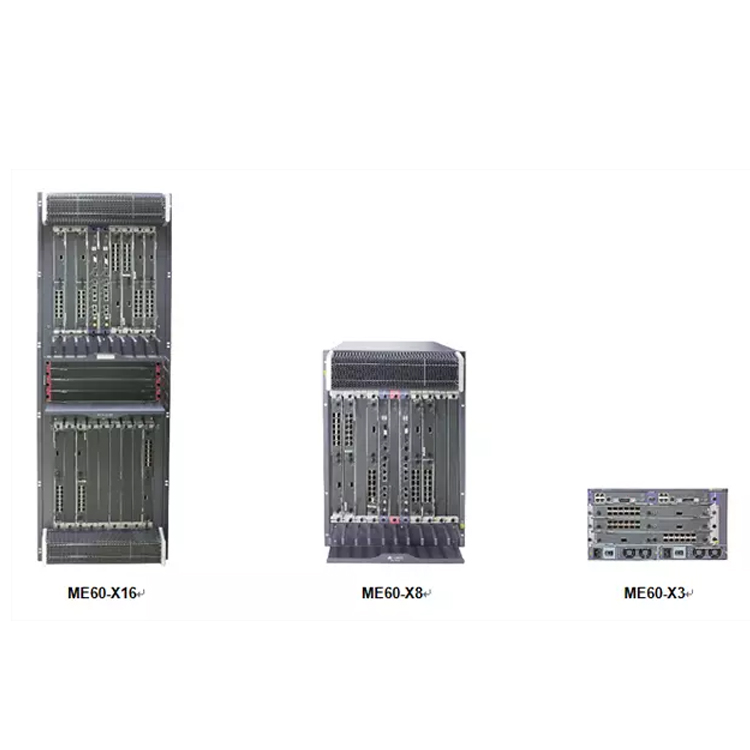Supporting 240G Subscriber Access Line Cards Huawei ME60-X8 Gateway
Product Description
High-capacity Broadband Remote Access Server (BRAS) with tightly integrated Hierarchical QoS and unified user access and management features.
Highly scalable with slots to provide various port types from 64 Kbit/s to 100 Gbit/s, up to 240 Gbit/s subscriber access line card. Supports up to 64K subscribers per Line Processing Unit (LPU), up to 256,000 subscribers per chassis.
Rich IPv6 support and industry’s largest capacity Carrier Grade NAT (GCG) service board enable smooth migration from IPv4 to IPv6 networking.
|
Attribute |
ME60-X16A |
ME60-X8A |
ME60-X16 |
ME60-X8 |
ME60-X3 |
|
|---|---|---|---|---|---|---|
|
Switching Capacity |
50.32 Tbit/s |
25.16 Tbit/s |
12.58 Tbit/s |
7.08 Tbit/s |
1.08 Tbit/s |
|
|
Forwarding Performance |
11,520 Mpps |
5,760 Mpps |
5,760 Mpps |
2,880 Mpps |
360 Mpps |
|
|
Number of Slots |
22 slots, including 16 LPUs, 2 SRUs, and 4 SFUs |
12 slots, including 8 LPUs, 2 SRUs, and 2 SFUs |
22 slots, including 16 LPUs, 2 SRUs, and 4 SFUs |
11 slots, including 8 LPUs, 2 SRUs, and 1 SFU |
5 slots, including 3 LPUs and 2 SRUs |
|
|
Dimensions |
1,778 mm x 442 mm x 650 mm (40U) |
934 mm x 442 mm x 650 mm (21U) |
1,420 mm x 442 mm x 650 mm (32U) |
620 mm x 442 mm x 650 mm (14U) |
175 mm x 442 mm x 650 mm (DC 4U); |
|
|
Maximum Power Consumption |
7,220W (BSUF-240) |
4,110W (BSUF-240) |
4,610W (BSUF-100) |
2,340W (BSUF-100) |
920W (BSUF-100) |
|
|
Full Configuration Weight |
356 kg |
190 kg |
279 kg |
136 kg |
DC: 42 kg (100G) |
|
|
Interface Types |
100 GE-WAN/LAN |
|||||
|
BRAS |
User access protocols: PPPoE, IPoE, 802.1X, and ND access |
|||||
|
L2TP |
Maximum number of sessions supported: 64K per slot and 128K per device |
|||||
|
IPv4 |
Supports the static routing protocol and dynamic routing protocols, such as RIP, OSPF, IS-IS, and BGP-4. All ports support line-rate forwarding even in complex routing environments, for example, when route flapping occurs |
|||||
|
IPv6 |
Supports the following:
Internet Control Message Protocol Version 6 (ICMPv6) Management Information Base (MIB), User Datagram Protocol Version 6 (UDP6) MIB, TCP6 MIB, and IPv6 MIB |
|||||
|
MPLS/MPLS VPN |
Supports the following:
Multicast VPN |
|||||
|
Layer 2 Features |
Supports the following:
Filtering list based on MAC addresses and ports |
|||||
|
Reliability |
Supports the following:
Intra- or inter-CGN service chassis 1+1 and 1:1 hot backup |
|||||
|
QoS |
|
|||||
|
Value-added Service |
Supports Enhanced Dynamic Service Gateway (EDSG), which identifies various user services based on traffic destination addresses and implements independent rate limit, accounting, and management for each service |
|||||
|
Multicast |
Supports the following:
Two-level multicast replication on the SFU and LPU to achieve optimal multicast service performance |
|||||
|
Security |
Supports the following:
|
|||||
|
Operating Environment |
Long-term operating temperature: 0°C to 45°C |
|||||
|
Short-term operating temperature: –5°C to 55°C |
||||||
|
Long-term operating humidity: 5% to 85% |
||||||
|
Short-term operating humidity: 0% to 100% |
||||||
|
Operating altitude: Equal to or below 4,000m |
||||||
You can contact us any way that is convenient for you. We are available 24/7 via fax, email or telephone.


